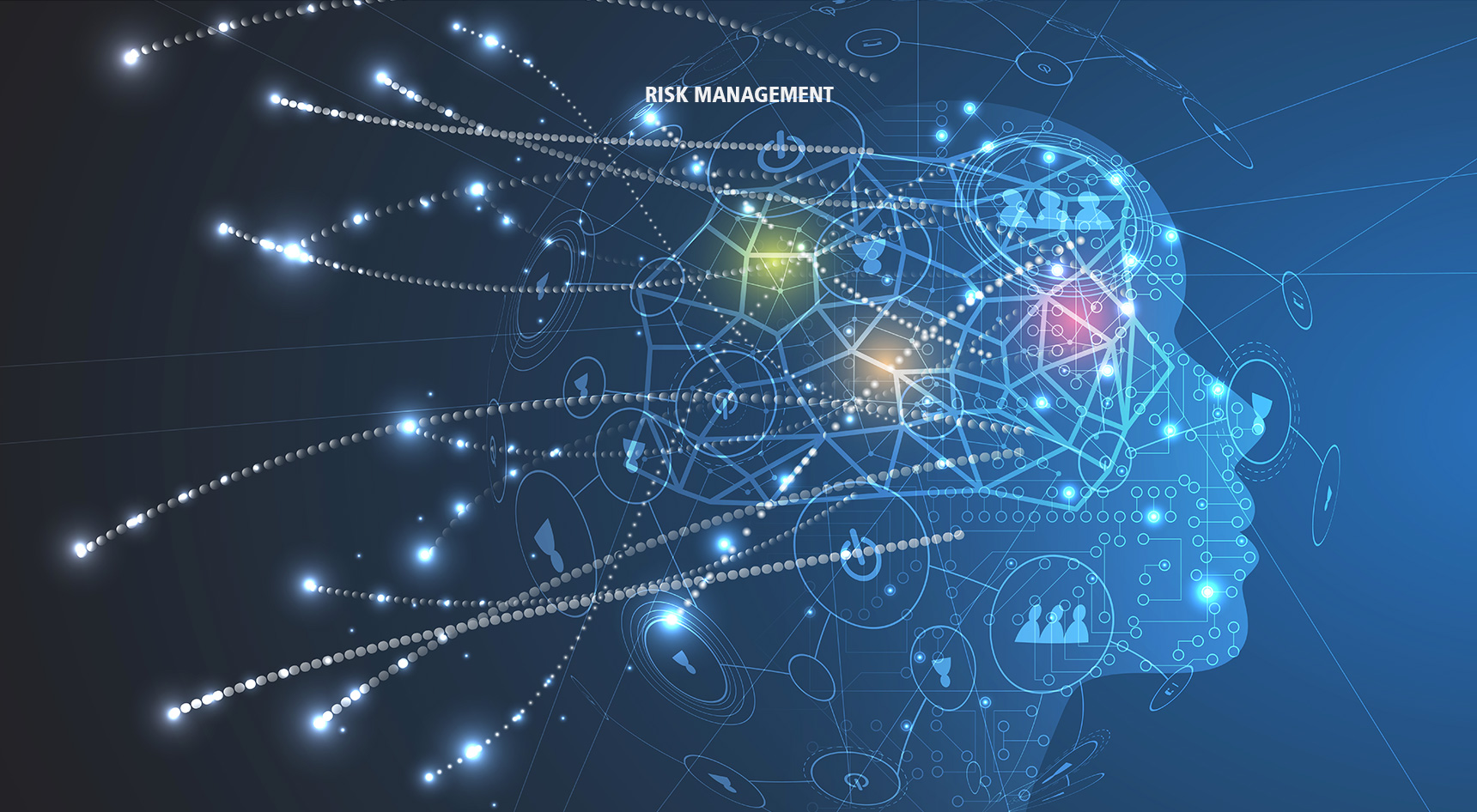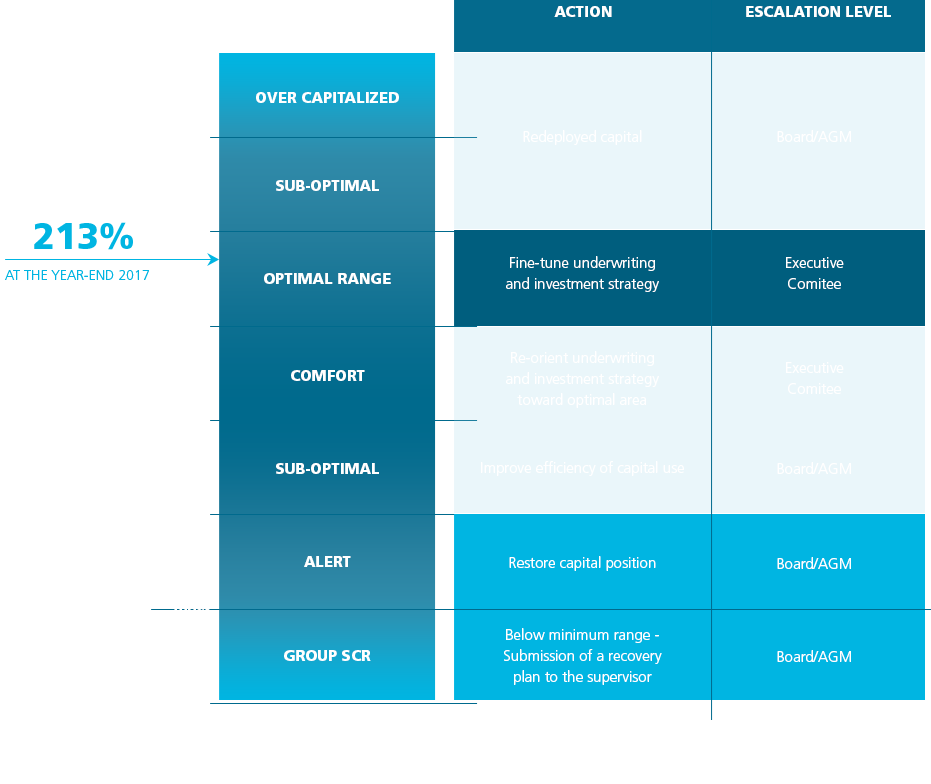


Frieder Knüpling
Group Chief Risk Officer of ScoR
« SCOR recognizes that risk management should not only be the domain of dedicated Risk Management teams, but should be a concept that is understood and put into practice throughout the company. The Group’s leadership encourages a healthy risk culture, which is reinforced though appropriate messaging behaviors and internal trainings. »
SCOR’S RISK MANAGEMENT SYSTEM
SCOR’s risk management system is composed of two interconnected parts:
- The risk appetite framework;
- The Enterprise Risk Management (ERM) framework, consisting of various risk management mechanisms which help to ensure that the risk profile is dynamically optimized, whilst remaining within the risk appetite framework.

DEFINING RISK APPETITE
As part of its capital management, a (re)insurer’s risk appetite defines the quantity of risk that it wishes to accept to achieve a desired level of profitability. Risk appetite can differ from one (re)insurer to another. Whether a company’s risk appetite is low or high, the management needs to properly understand its consequences. SCOR has an upper mid-level risk appetite, which is revised every three years. SCOR currently uses a solvency ratio target range and an expected profitability target to provide a complete definition of its risk appetite.
SCOR’s risk appetite framework is at the heart of its decision making, and is part of its strategic plan, “Vision in Action”.
The Group notably relies on specific tools to monitor its risk exposures and compare them against the limits set out in its risk appetite framework:
- The “risk driver” system, which ensures that the Group’s annual aggregate exposure to each major risk category is well managed. The objective is to avoid over-concentration of risk and hence maximize diversification benefits;
- The “extreme scenario” system, which is designed to avoid the Group’s over-exposure to one single event.
“Footprint scenarios“ are an important complementary approach to analyzing risk exposure, providing an impact assessment on the Group under selected deterministic scenarios. SCOR uses either key historical events or other extreme events to assess their impact on an “as-if” basis on the current portfolio, taking into account current retrocession and hedging mechanisms.

SCOR’S INTERNAL MODEL
SCOR has developed a full and holistic internal model over the last 10 years, covering all material quantifiable risks to which the Group is exposed (Life and P&C underwriting risk, market and credit risk, operational risk) and reflecting SCOR’s risk profile and strategy. SCOR’s internal model simulates the interactions between the assets and liabilities of the Group under various scenarios and determines the capital level necessary to ensure that the Group is solvent with a probability of 99.5% over a 1-year time horizon.
Since January 1st, 2016, the regulatory solvency position of the Group is assessed by SCOR’s internal model and it is also used to help to prepare for management decisions involving risk management or solvency considerations, in particular to:
- Define the Group’s underwriting plan and verify its consistency with the risk drivers and risk limits;
- Help the management to monitor compliance with all the limits that have been set;
- Support the analysis of strategic decisions, such as Mergers & Acquisitions or significant investment decisions.
SCOR’S CAPITAL
SHIELD STRATEGY
A Robust Capital Shield is one of the cornerstones of SCOR’s strategy. The primary purpose of the Capital Shield Strategy is to ensure that the Group adheres to the risk tolerance limits as defined in the Risk Appetite Framework, so that SCOR’s capital and solvency are protected. The Capital Shield Strategy is based on two concepts:
- The Group’s gross exposure is mitigated through traditional retrocession and other hedging mechanisms (such as capital markets solutions or contingent capital facilities) to achieve an acceptable net risk exposure;
- Through the Solvency buffer (or Capital buffer) and the Group’s dynamic solvency scale, SCOR monitors the amount of capital necessary to respect the Group’s risk/return objectives and safeguard its franchise.
SCOR’S DAY-TO-DAY CAPITAL MANAGEMENT
SCOR has developed a solvency scale which drives a process of gradual escalation and management responses, depending on its solvency position based on the internal model. The optimal capital range (defined as a solvency ratio of 185-220%) enables the Group to achieve the best balance between a strong solvency level and efficient use of capital. Hence, SCOR aims to make the best possible use of the numerous options at its disposal to manage and steer its risk and capital positions toward the optimal area.


MANAGEMENT AND MITIGATION OF CLIMATE RISKS
As part of SCOR’s commitment to Corporate Social Responsibility, the Group undertakes to manage climate risks in a holistic manner, encompassing both the company’s assets and underwriting liabilities, while investing in projects that contribute to the transition towards a renewable energy future.
SCOR’s approach to climate risk management and mitigation includes:
- Assessing and addressing climate-related risks and opportunities for the business;
- Contributing to the understanding of climate-related risks, e.g. by developing and improving its own catastrophe modeling tools and through partnerships with scientific organizations researching the modeling of climate events;
- Analyzing the exposure of SCOR’s assets to acute physical risks (e.g. exposure to natural catastrophes such as hurricanes, extra-tropical cyclones and floods);
- Investment in solutions for climate risk adaptation, such as Insurance Linked Securities, that offer protection against natural disasters by helping to fund post-event reconstruction;
- Contributing to the transition towards renewable energy through both the development of insurance coverage products for renewable energy technologies and investment in renewable energy projects;
- Limiting SCOR’s operational environmental footprint by funding carbon-compensation strategies (e.g. forest preservation and reforestation projects);
- Divesting from companies deriving more that 30% of their turnover from thermal coal.

THE CRO FORUM’S EMERGING RISK INITIATIVE
In 2017, SCOR coordinated the production of the CRO Forum’s position paper on Autonomous machines, published in November.
Autonomous machines are used in almost all sectors of today’s economy and have wide implications for both the re/insurance industry and society at large.
Including self-driving cars, robots and autonomous equipment used for manufacturing, mining, farming, transport, medical care and even lethal autonomous weapons, the uses for autonomous machines are developing rapidly and bring with them new legal, regulatory, societal and ethical considerations.
This position paper summarizes the main issues that the re/insurance industry currently faces as a result of advances in the use of autonomous machine technology. The paper is illustrated with practical examples covering the current uses of the technology and the risks and opportunities that these present for the (re)insurance industry.
The CRO Forum emphasizes the link between many emerging risks and sustainability risks. Previous papers that discuss sustainability risks in the context of the insurance industry include those published on water risks and food security risks.
In 2018, the CRO Forum’s position paper will be on the subject of Climate Change.

RISK CULTURE AT SCOR
SCOR’s risk management system is supported by a healthy risk culture throughout the Group. The tone of the company’s risk culture is set by top management and from here spreads to the entire workforce. SCOR is continually working to raise awareness of risk-related issues and in 2017, initiatives to develop understanding among SCOR’s staff on key risk management concepts included the launching of a compulsory e-learning module on risk management. Interest in risk management issues throughout the company is also encouraged by the quarterly publication of the Group’s “Risk Tales”, which present easy-to-understand case-studies, providing real-life examples of where things can go wrong without good risk management practices. In addition, SCOR’s established Emerging Risks process is open to contributions from all staff members and spreads knowledge throughout the company on trends in new or rapidly developing risks.